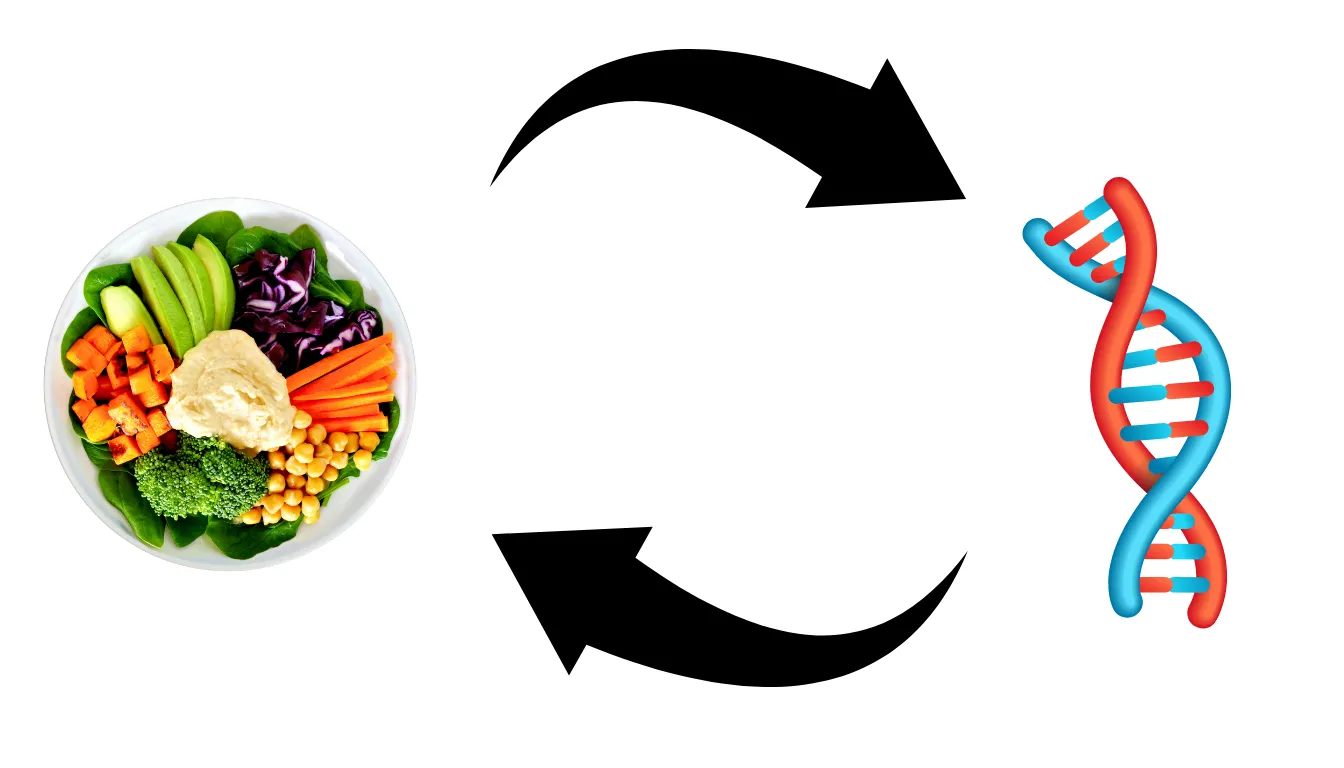
Ever thought why your friend can eat pizza daily without gaining weight, while you gain five pounds just looking at carbs? The answer might be hiding in your DNA. Your genes don’t just determine your eye color or height—they’re actively chatting with every bite you take, influencing how your body processes nutrients and responds to different foods.
Scientists have discovered over 10 million genetic variations that affect how you metabolize nutrients, meaning your morning coffee may have a completely different effect on you than it does on your coworker. These nutrient-gene interactions explain why some people thrive on high-carb diets, while others require more protein, or why specific vitamins work wonders for some individuals but have little to no effect on others.
Understanding how your unique genetic makeup interacts with what you eat can transform everything from preventing diabetes to optimizing your energy levels, making personalized nutrition the future of maintaining good health.
Key Takeaways
Your genes actively influence how you process every nutrient, with over 10 million genetic variations affecting metabolism, which explains why identical diets produce vastly different results in individuals.
Nutrigenomics works as a two-way conversation between your DNA and diet—nutrients can turn genes on or off (nutrigenomics), while genetic variants determine how effectively you process specific nutrients (nutrigenetics).
Personalized nutrition, based on genetic testing, eliminates dietary guesswork, allowing healthcare providers to create precise meal plans tailored to individual genetic blueprints, rather than relying on trial-and-error approaches.
The nutrigenomics market is rapidly expanding, growing from $0.96 billion in 2024 to $1.14 billion in 2025, driven by the adoption of AI-powered genetic testing and increasing demand for precision medicine approaches.
Key genetic variants, such as MTHFR and FADS genes, significantly impact nutrient needs, with some individuals requiring dramatically different amounts of folate, omega-3 fatty acids, or other essential nutrients based on their genetic makeup.
Epigenetic interactions mean that your food choices can influence gene expression for generations, with research showing that nutritional decisions can modify genetic switches that affect both current health and the health of future offspring.
Table of Contents
Introduction
Folate and other nutrients can affect genes in a myriad of ways—some beneficial and others harmful. In the proper category, folate can prevent certain types of congenital disabilities by influencing how genes direct the formation and growth of the brain and spinal cord. In the harmful category, folate can increase cancer risk by controlling how genes direct the growth of cells.
Nutrient-gene interactions are akin to a dialogue within the body. Nutrients and their metabolites regulate the expression of many genes essential to the conversation among cells in the body. They influence cell signaling processes that govern many cellular and tissue functions, ultimately affecting the entire organism.
Nutrigenomics examines the influence of nutrients on gene activity and how genetic differences determine our responses to nutrients. For example, two people might consume the same amount of a nutrient. Still, one person may thrive on it while the other struggles with it, and this is often determined by genetic differences in how their bodies process that nutrient.
Key Concepts and Definitions
Understanding the building blocks of genetic nutrition interactions feels like learning a new language—one where your DNA does the talking and your diet does the listening.
Nutrigenomics vs. Nutrigenetics
Nutrigenomics is akin to having a conversation with your genes through your diet. When you eat those omega-3s from salmon or walnuts, you’re telling inflammatory genes to calm down. It’s fascinating—EPA and DHA fatty acids can downregulate those troublemaker genes in the NF-κB pathway that tend to trigger inflammation and increase the risk of obesity.
Think of it as your diet sending direct messages to your genetic control center.
Nutrigenetics, on the other hand, flips the script. It’s about how your genetic variations influence your response to nutrients. One patient felt awful, despite following every folate recommendation in the book. It turns out that her MTHFR gene variant made folate metabolism more challenging. Without enough bioavailable folate, neural tube defect risks skyrocket during pregnancy.
This is where genetic nutrition interactions get personal. Your genes aren’t just sitting there—they’re actively changing how you process every nutrient that crosses your lips.
Integration involves considering how nutrients influence gene expression and how genetic variations impact nutrient responses. This provides a more personalized nutrition approach that considers epigenetic changes, such as DNA methylation—chemical tags that nutrients can add or remove from your genes.
Mechanisms of Interactions
The magic happens at three primary levels:
Transcriptional regulation works like a molecular key-and-lock system. Fatty acids bind to receptors called PPARs, turning genes on or off like light switches. Resveratrol from red grapes? It’s modulating estrogen receptors at the genetic level, not just providing antioxidants.
Epigenetic modifications are where things get multigenerational. Folate and B vitamins don’t just help you—they’re rewriting your genetic instruction manual through DNA methylation. Here’s a sobering example: prenatal famine can alter IGF2 gene methylation, setting up offspring for a higher risk of obesity decades later.
Enzyme interactions create fascinating competitive dynamics. Flavonoids compete for enzymatic binding sites. When you drink green tea, those compounds inhibit aromatase (CYP19A1), thereby reducing estrogen production. For breast cancer prevention, this nutrigenomics interaction could be game-changing.
Role of Bioactive Compounds
Your plate is essentially a pharmacy of genetic modulators. Every bite contains compounds that can influence gene expression in ways we’re just beginning to understand.
Basic nutrients like carbohydrates, fatty acids, minerals, and vitamins aren’t just fuel—they’re genetic regulators. Vitamin D enhances calcium absorption by interacting directly with VDR genes.
Phytochemicals are the real heavy hitters. Flavonoids in green tea and soy isoflavones compete for enzymatic sites, literally changing hormone levels through genetic pathways.
Microbiome connections add another layer of complexity. Your gut bacteria influence nutrient-gene pathways in ways that will directly affect your health. Plant-based diets promote bile-resistant bacterial species that affect gene expression throughout your body. It’s a three-way conversation between your genes, your food, and your microbes.
Understanding these nutrigenomics interactions means you’re not just guessing anymore. You’re working with precise molecular mechanisms that can predict and prevent chronic conditions at the genetic level.

Historical Context
The journey of understanding dietary interventions based on genetics started long before anyone coined the term “nutrigenomics.“
Origins of the Field
Foundational discoveries emerged from unexpected places. Back in 1909, British physician Archibald Garrod stumbled onto something innovative while studying children with peculiar metabolic quirks. He identified inborn errors of metabolism—like phenylketonuria (PKU)—where your genetic blueprint determines whether certain foods become friend or foe.
Picture this: a child born with PKU can’t process the amino acid phenylalanine. Without understanding genetic nutrition interactions, that morning protein shake can become toxic. Garrod‘s work proved that your DNA doesn’t just determine eye color—it shapes how every nutrient gets processed.
Evolution carved our genetic responses over millennia. Your ancestors thrived on balanced omega-6 to omega-3 ratios, roughly 1:1 to 4:1. Modern diets? We’re talking 15:1 or higher. Those ancient genes are still calling the shots, which explains why nutrigenomics interactions reveal such dramatic differences in how people respond to today’s food world.
Key Milestones
The Human Genome Project revolutionized the field in the 1990s. Imagine trying to understand how genes affect nutrition without knowing what those genes look like—that was healthcare before 2003. Once scientists mapped human DNA, they could finally identify which genetic variants respond to specific nutrients.
Official establishment came in 2003. Nutrigenomics got its formal name and framework, building on systems biology to study whole-body responses rather than just isolated nutrients.
Recent advances since 2007 have brought the field into sharp focus. RNA sequencing and transcriptomics enable researchers to observe genes switching on and off in real-time as nutrients flow through the system.
Evolution to Modern Applications
Early research focused on single-gene stories. Scientists would study genes like FADS1 and FADS2 for fatty acid metabolism—meaningful work, but like trying to understand a novel by reading one chapter. The hypothesis-driven approach provided us with valuable insights, but it overlooked the broader context.
Multi-omics approaches revolutionized the field. Modern nutrigenomics examines your entire genetic orchestra, as well as your microbiome, metabolome, and proteome.
The Dutch Hunger Winter of 1944-45 proved that genes remember what you eat. Children born to mothers who experienced famine showed epigenetic changes that affected their health decades later. Your grandmother’s diet might still be influencing your genetic expression today—that’s how powerful these nutrient-gene interactions are.
Today’s practitioners can access genetic testing that would’ve seemed like science fiction just twenty years ago. What began with one doctor noticing unusual metabolic patterns has evolved into personalized nutrition plans tailored to your unique genetic makeup.

Current State and Trends
The nutrigenomics field is experiencing a remarkable transformation in 2025. You’re witnessing the convergence of artificial intelligence, expanded genetic testing, and growing consumer demand for truly personalized healthcare solutions.
Advancements in Technology
AI is completely changing the game when it comes to forecasting the interaction of your genes with various nutrients. These complex algorithms can now parse millions of genetic variants, along with dietary patterns, to generate highly accurate recommendations—it’s like looking into a crystal ball to see your nutrient metabolism. Machine learning models are becoming increasingly adept at identifying patterns that human researchers might overlook entirely.
The testing of microbiomes has also achieved a new level of precision. By the year 2025, you will be able to grasp in explicit detail how your singular gut bacteria influence your nutrient-gene pathways. Companies have now turned their attention to the complex interplay between your microorganisms and genetic expression. They appear to be creating—if not yet in whole, then in part—a personalized roadmap of sorts that will guide you to optimal nutrition.
Big data integration enables these AI systems to process your genetic profile, microbiome composition, lifestyle factors, and even your stress patterns, delivering recommendations that feel almost telepathic in their accuracy.
Market and Adoption Growth
The nutrigenomics market is expected to grow significantly, from $0.96 billion in 2024 to $1.14 billion in 2025, driven by the adoption of personalized nutrition approaches for managing obesity and cancer. Functional medicine practitioners are utilizing tools like genome-wide association studies (GWAS) to evaluate how multiple genes contribute to health risks. Clinical adoption is accelerating, as healthcare providers recognize that understanding genetic nutrition interactions can help prevent costly health issues.
The global shift toward sustainable, plant-based diets is also getting a genetic makeover. Instead of one-size-fits-all plant-based recommendations, you can now determine which plant compounds work best with your specific genetic makeup.
Food science is evolving rapidly with AI-multi-omics convergence, meaning researchers can simultaneously analyze your genes, proteins, metabolites, and microbiome to understand your complete nutritional picture.
Research Focus Areas
Researchers are exploring personalized nutrition based on individual genetic profiles. For instance, individuals with specific FADS gene variants may require higher levels of omega-3 fatty acids to reduce their risk of heart disease. This is now a practical science shaping heart health advice.
Epigenetic therapies are advancing, showing how nutrients can alter gene expression to slow aging and prevent diseases. Resveratrol stands out for its potential anti-cancer effects through these mechanisms. Certain foods might deactivate harmful genes and activate protective ones, offering new ways to combat health issues.
Nutrigenomics examines how genetic nutrition interactions evolve across various stages of life. As you age, your genetic needs may shift, requiring adjustments. Research shows that these interactions elicit unique responses, ranging from caffeine processing to vitamin D absorption, suggesting that generic diets are becoming outdated. Gene expression through diet is also seen in emerging research on microRNA regulation.
Actionable Takeaways
Start smart with high-impact testing. Focus on the key players—MTHFR and FADS genes—especially for patients struggling with persistent weight issues or unexplained fatigue. These genetic variants pack the biggest punch for your practice dollar.
You’ll want to begin with patients who’ve tried “everything” but still struggle. That’s your sweet spot. Think about the person who couldn’t lose weight even though perfect compliance with standard advice—turns out her FADS gene variant meant she needed triple the omega-3s most people require.
Ditch the dietary myths while you’re at it. Your patients are drowning in contradictory nutrition advice from social media influencers who think kale supports cancer. Use genetic testing results as your North Star—hard science beats Instagram wellness gurus every time.
AI tools are your new best friend in this regard. They’ll crunch complex genetic data faster than you can say “methylenetetrahydrofolate reductase.“ But remember—technology amplifies good judgment, it doesn’t replace it.
Monitor outcomes like a hawk. Track biomarkers, energy levels, and patient satisfaction. Nutrigenomics interactions aren’t just about fancy reports—they’re about real people feeling genuinely better. Document everything, because insurance companies are finally starting to take notice.
Collaborate with genetic counselors and registered dietitians who “get” this stuff. You wouldn’t perform surgery without proper training—same logic applies to interpreting complex genetic nutrition interactions.
Next Steps
Ready to dive deeper? Consider our nutrigenomics program, which will give you street cred and actual skills. The field’s evolving so rapidly that what you learned in nutrition school might already be collecting dust.
Start with one challenging case—maybe that patient who metabolizes caffeine like molasses or can’t handle standard B-vitamin supplements. Test their genetics, adjust their plan, and watch the magic happen.
Keep learning by joining professional societies that share real-world case studies. Your patients deserve cutting-edge care, not yesterday’s recommendations.
The future of healthcare is personalized, precise, and powered by your DNA. Jump in now—2025 is your year to revolutionize how genes affect nutrition in your practice.
Conclusion
Your genetic blueprint isn’t just a fixed destiny—it’s a dynamic conversation between your DNA and every meal you eat. Understanding these nutrient-gene interactions gives you the power to work with your biology instead of against it.
The days of one-size-fits-all nutrition advice are numbered. As genetic testing becomes more accessible and AI tools get smarter, you’ll soon have the ability to make dietary choices that align perfectly with your unique genetic makeup.
This isn’t just about optimizing your health—it’s about revolutionizing your approach to food as a form of medicine. Your genes might load the gun, but your diet pulls the trigger. The exciting part? You’re now learning how to aim better.
Frequently Asked Questions
What is nutrigenomics and how does it differ from nutrigenetics?
Nutrigenomics studies how nutrients influence gene expression, while nutrigenetics examines how genetic variations affect nutrient responses. Nutrigenomics focuses on how foods can turn genes “on” or “off,“ whereas nutrigenetics looks at how your unique DNA affects how you process different nutrients. Together, they form the foundation of personalized nutrition, enabling dietary recommendations tailored to your unique genetic makeup.
How do genetic variations affect individual dietary needs?
Over 10 million genetic variations can influence how your body metabolizes nutrients. These variations affect enzyme production, nutrient absorption, and metabolic pathways. For example, FADS gene variants determine your omega-3 fatty acid needs, while MTHFR gene variations impact folate processing. This means two people can have completely different nutritional requirements based on their unique genetic profiles.
What role does AI play in personalized nutrition?
AI enhances nutrigenomics by analyzing complex genetic data to predict gene-nutrient interactions that human researchers might miss. Machine learning models identify patterns across vast datasets, enabling more accurate personalized nutrition recommendations. AI tools assist healthcare practitioners in interpreting genetic testing results and creating evidence-based dietary plans tailored to individual genetic profiles, thereby making personalized nutrition more accessible and precise.
How does the microbiome influence nutrient-gene interactions?
Your gut bacteria significantly impact how nutrients interact with your genes. The microbiome affects nutrient absorption, produces bioactive compounds, and influences genetic expression. Different bacterial strains can modify how your body processes foods and responds to nutrients. This complex interplay between genes, diet, and gut bacteria adds another layer to personalized nutrition, requiring consideration of both genetic makeup and microbiome composition.
What are the key mechanisms of nutrient-gene interaction?
Nutrient-gene interactions occur through three main mechanisms: transcriptional regulation (nutrients acting as signals to turn genes on/off), epigenetic modifications (changes in gene expression without altering DNA sequence), and enzyme interactions (nutrients affecting protein function). These mechanisms allow nutrients to act as genetic modulators, influencing health outcomes and disease risk at the molecular level.
How has nutrigenomics evolved since its early discoveries?
Nutrigenomics originated from early 20th-century discoveries by Archibald Garrod regarding metabolic disorders. The Human Genome Project in the 1990s was pivotal, enabling the mapping of DNA and understanding genetic responses to nutrients. The field has evolved from studying single genes to a multi-omics approach considering the entire genetic landscape, microbiome, and other biological systems for comprehensive personalized nutrition strategies.
What genetic tests are most important for personalized nutrition?
High-impact genetic tests focus on genes such as MTHFR (folate metabolism), FADS (omega-3 processing), and those affecting caffeine metabolism, lactose tolerance, and gluten sensitivity. These tests can address stubborn weight issues, unexplained fatigue, and chronic health problems. Genome-wide association studies and polygenic risk assessments provide broader insights into genetic predispositions and optimal dietary approaches for individual patients.
How can healthcare practitioners implement nutrigenomics in their practice?
Practitioners should begin with high-impact genetic testing for common variants, utilize AI tools to analyze complex genetic data, and closely monitor patient outcomes to demonstrate the effectiveness of their approach. Collaboration with genetic counselors and registered dietitians ensures accurate interpretation and understanding. Ongoing education and certification in nutrigenomics are essential. Moving away from one-size-fits-all dietary advice toward evidence-based, genetically-informed recommendations improves patient outcomes.
References
Kohlmeier, L., DeMarini, D., & Piegorsch, W. (2009). Gene-nutrient interactions in nutritional epidemiology. https://doi.org/10.1093/ACPROF:OSO/9780192627391.003.0011.
Vimaleswaran, K. (2017). Gene–nutrient interactions on metabolic diseases: Findings from the GeNuIne Collaboration. Nutrition Bulletin, 42, 80-86. https://doi.org/10.1111/NBU.12252.
Hargrove, J., & Berdanier, C. (2018). Nutrient Receptors And Gene Expression. , 1-22. https://doi.org/10.1201/9781351075114-1.
Huang, J., & Vieira, A. (2006). DNA methylation, riboswitches, and transcription factor activity: fundamental mechanisms of gene–nutrient interactions involving vitamins. Molecular Biology Reports, 33, 253-256. https://doi.org/10.1007/s11033-006-9005-y.
Vimaleswaran, K. (2021). GeNuIne (gene–nutrient interactions) Collaboration: towards implementing multi-ethnic population-based nutrigenetic studies of vitamin B12 and D deficiencies and metabolic diseases. Proceedings of the Nutrition Society, 80, 435 – 445. https://doi.org/10.1017/S0029665121002822.

